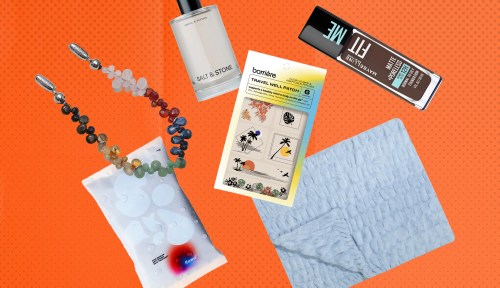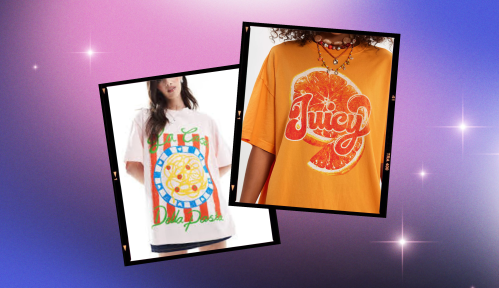Our editors independently select these products. Making a purchase through our links may earn Well+Good a commission
These Are a Bra Expert and Lactation Consultant’s 18 All-Time Favorite Nursing Bras
Finding the perfect bra when you're nursing is no easy feat. These are the best nursing bras, according to the experts.

As a bra expert who breastfed, pumped and formula fed, I learned firsthand what makes a good nursing bra. Easy-to-use clasps and hands-free features are game-changers when you’re knee deep in your feeding journey. Nursing bras have finally caught up with what new moms want and need—and that’s because moms are in charge of the best new bra brands!
Experts in This Article
Modern nursing bras are soft, breathable, bacteria-free, and even made with fair trade organic cotton. These bras can be seamless and hardware-free all while lifting and supporting without underwire. And if you’re a pumper (raises hand), the new pumping bras hold the flanges in place and can even work with wearable pumps like the Willow, Elvie, and Freemie.
A good supply of nursing bras will get you through your last trimester and well through your first year. So when do you start buying nursing bras? How many do you need? And what size do you buy? To answer the questions I am asked most about nursing bras, I went straight a couple of experts—RN, lactation consultant and Bobbie Medical Advisor, Jadah Parks Chatterjee, and bra expert Jenny Altman.
When do you suggest shopping for nursing bras?
During the third trimester you can transition to a nursing bra, as you will get good use out of it, until your breasts become more full during postpartum, if you are breastfeeding.
Do you need to pack nursing bras for the hospital ?
“I recommend having 1-2 nursing bras before the hospital delivery to wear once you are home from the hospital,” says Parks Chatterjee. During the first 100 hours postpartum, it’s recommended to provide skin to skin contact with the baby, so a bra is not necessary unless you are planning to begin suppressing lactation.
Do you suggest nursing bras fit loose or fitted in the band and the cup since size fluctuates so often?
We want the bra to be well-fitted, says Parks Chatterjee. It’s inevitable that your breast size will change as you increase your volume of milk. The band of the bra is everything: It literally has your back at all times, holding it all together. The band should be snug, keeping your breasts in the cup and keeping the straps from falling off of your shoulders. The straps should never dig in. If you can place two fingers under the strap, with a snug fit, that’s a good indicator the strap will remain in place and feel secure even when you’re opening/closing the nursing clips. The cup size is dependent on the circumference of your breasts. The point of the bra is to provide support, so your breasts should fit into the cup, without spilling out of the top or side of the breasts. A good nursing bra will have flex fabric to account for the size change throughout the day.
Adds Altman, “Sizing for your nursing bra should be supportive but comfortable. Don’t let the bra band feel tight or rigid, it will only get more uncomfortable as the days go on. Cup size should give you coverage at mid-full, which means the cup will expand with you as your breasts get more full before a nursing session.”
Is the traditional clip style nursing bra easier to use for nursing then a cross-over bra that moves to the side for nursing?
Parks Chatterjee says this is a personal preference. “When I was nursing my child, I moved away from nursing bras with the clip when I went back to work. I went for crossover bras that could be pulled to the side. I was looking for all things with ease on my days off from professional work.”
Is wire or wire-free better for milk production?
This, too, is a personal choice. The key to either is a proper fit, especially when wearing a nursing bra with a wire. We want to decrease the risk of inhibiting milk flow, which can lead to engorgement and/or plugged ducts. A bra that is correctly fitted should not create concern.
How many nursing bras should you have?
You’ll need about 4-5 bras on hand, says Altman, because you’ll want to rotate your bras each day or anytime you have a leakage. (This is also why mom brands also sell multiples of bras). “A smelly, wet bra is the worst. Just throw them in the wash as often as your burp cloths,” she says. Shop for stretchy, breathable fabrics that will grow with you and wash easily.
To care for nursing bras, Altman says you can wash them in the washing machine and hang to dry. “I’m a big believer in hand-washing, but not during breastfeeding. Ain’t no mom who’s got time for delicates right now!”
With all this in consideration, here are the best nursing bras for your needs—according to the pros who truly do have your back.
Best nursing bras, hands down
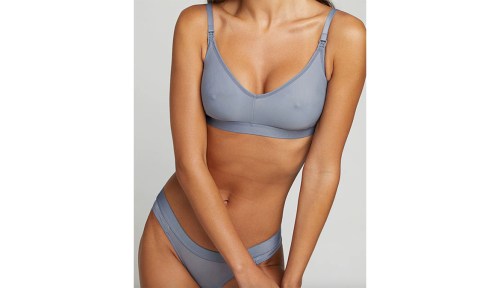
Negative, Silky Nursing Bra — $65.00
Leave it to breastfeeding lingerie designers to create a nursing bra so comfortable, you can wear it 24/7. Aside from the nursing clips, this feels like a slim, modern bra that’s less like most of the maternity clothes you’re likely wearing about now.
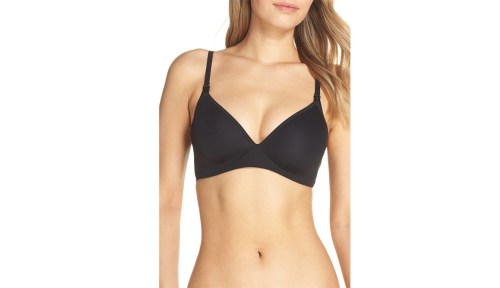
On Gossamer, Next to Nothing Wire Free Nursing Bralette — $44.00
This wireless microfiber nursing bra offers everyday flexibility and comfort thanks to its narrow straps and near-weightless four-way-stretch fabric. The lightly molded cups and side slings help to give you shape and nipple coverage. It’s a nursing bra that doesn’t scream “maternity” while giving all the function us new mamas need.

Everyday New to Nursing Starter Bundle by Storq — $179.00
If you’re getting prepped for your hospital trip, this bundle is a great way to be nursing ready. The bundle by Storq includes two of the Everyday Bras and two of the Soft Touch Nursing Tanks. The super soft and stretchy feel-like-nothing bras pull to the side when it’s time to nurse. The tanks have an internal shelf bra for light support and easy to use clips for nursing. Basically, get a bundle and you’ll be ready for your bundle! (Yes we did…)

Pepper Wirefree Nursing Bra — $65.00
Pepper bras are made for AA-B cups, and this nursing bra comes in sizes XXS-XL, ranging from 30A-40A. It has a one-hand clasp and drop-down cup to make nursing a little easier if your hands are already full. “Super soft and wirefree, the luxe feel of this fabric is just what nursing moms need,” says Altman. “The extra wide hook and eye and ballet back are great for back support just when your boobs feel like they are weighing you down.”
Best nursing bras for larger breasts
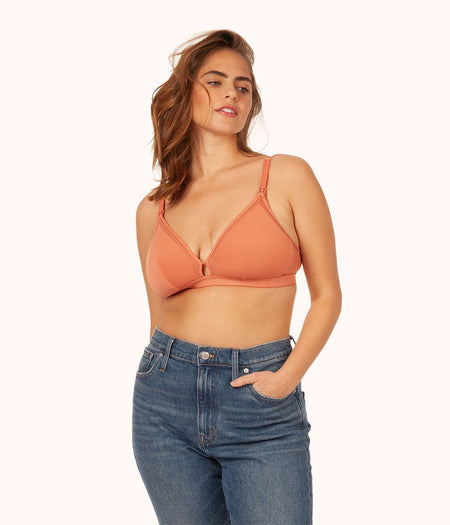
Lively, The Busty Maternity Bralette — $45.00
Created to accommodate large busted women, these bralettes comfortably support DD-DDD (band size 30-40). And let’s face it, if you love these, you’ll need at least three of them (there’s a bundle and save option)! The strong straps offer lift and support while the drop down cups do the job. You’ll comfortably wear these during your last trimester, well through the 4th and beyond.
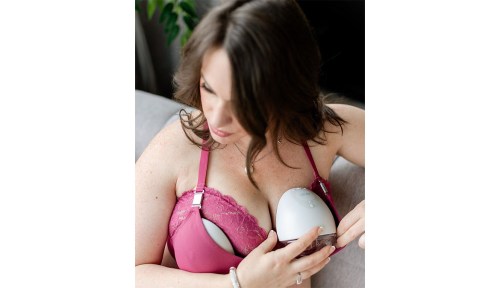
Ella Maternity, Nursing & Pumping Bralette — $69.00
Unique in design compared to the usual maternity bra, this lacey racerback has rose-gold clips and a wide, supportive underband. Available in sizes small-2X, breastfeeding moms can use this to nurse or as a hands- free option. We love a bralette that offers comfort and support in so many sizes, it’s not often a DD+ can feel this safe sans wire.

Knix, BlissFit Leakproof Nursing Bra — $55.00
Knix nailed it on the sizing by offering nursing bras in size small-3XL+ (that’s a range of 32A-42G!). The wireless support fabric, back close (going over the head is NOT always easy), easy clip clasps and removable leakproof pads tell us one thing—there is a mom of three behind this design!
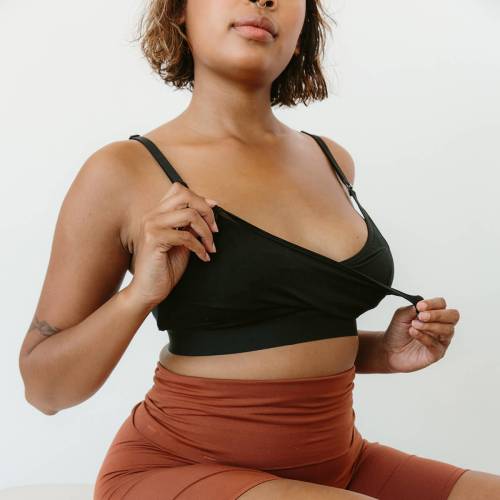
Storq Pumping & Nursing Bra Top — $56.00
This bra-within-a-bra gives the flexibility of wearing it whether you’re nursing, pumping, or otherwise. Says Altman, it unclips to reveal a bralette underneath, which has openings in the cups for pumping access, and pulls aside for nursing. And the soft micromodal fabric is great for stretch and recovery, so there’s no reason you can’t start wearing this mid-way through your pregnancy.
Best hands-free nursing bras
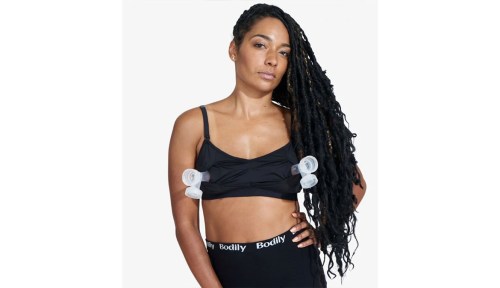
Bodily, The Do Anything Bra — $58.00
Someone got the memo! Created with a lactation consultant, this hands-free pumping bra is beautiful, practical and thoughtful. Between the soft silky fabric, the convertible straps, the extended back closure and the built-in slings (to hold the leak pads), these women clearly knew what breastfeeding was all about.
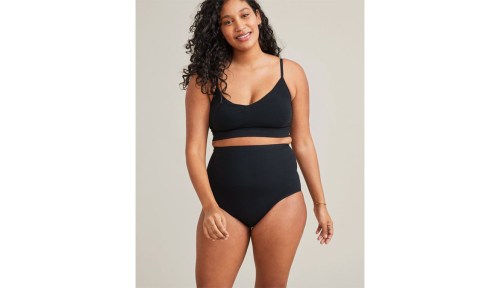
Hatch, The Essential Pumping Bra — $78.00
This super soft, luxe, modal bra offers comfortable support whether you’re breastfeeding or pumping. The hands-free feature means you can slide in the pump flanges and then give your hands a break. (This is the only reason I was able to type during those first months!) The pull-over style means no seams and no hard-ware. Add in the leak pads if you think you’ll need them. Mom to mom— you will.
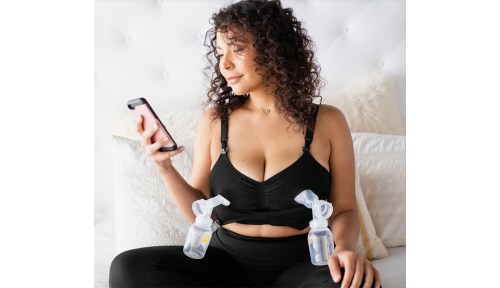
Kindred Bravely, Sublime Hands-Free Pumping & Nursing Bra — $60.00
Listen, you don’t 100 percent know if you’ll be breastfeeding, pumping, combo feeding or all of the above. So let’s be prepared for all the possibilities! This super soft wire-free bra has great band support, an extra wide hook and eye closure, straps that adjust in the front and easy to use nursing clips. As a hands-free bra, it holds standard pump flanges securely and also works with the new breed of wearable pumps. The Sublime comes in sizes S-XXL Busty, fitting sizes 30B-44I. (Bonus-each size comes with a bra extender!)
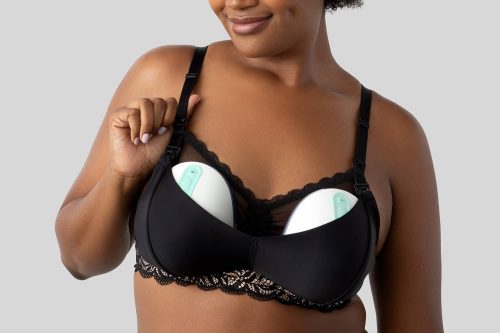
Willow Perfect Pumping Bra — $59.00
This bra not only holds a Willow Wearable Breast Pump securely in place, but it also does double duty as a pumping and nursing bra, says Altman. It has a ton of features, including wireless support, versatile straps, double extender clips, an extra wide hook, and a mesh panel across the bust that adjusts for the level of coverage you need at that moment.
Best nursing bras with support
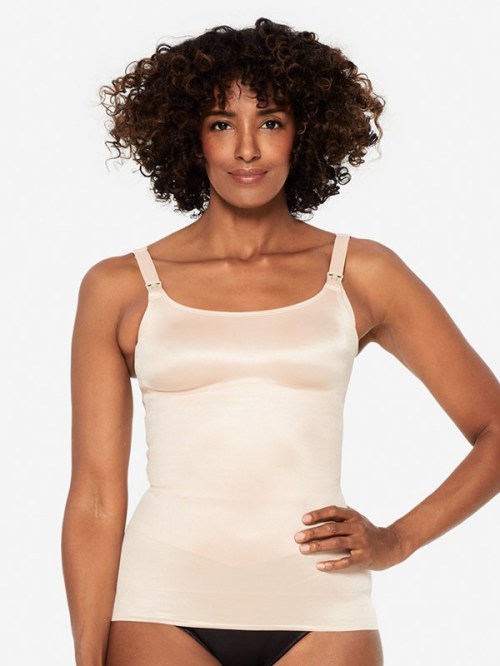
Ruby Ribbon, Nursing Cami — $79.00
When you want everything to just stay in place, and a little more belly coverage, this level 5 support cami does just that. This bra has all-over compression with 360-degree stretch for smoothing and support around the breasts and across the back. Plus, adjustable straps and one-hand release, because first and foremost, it’s for nursing!
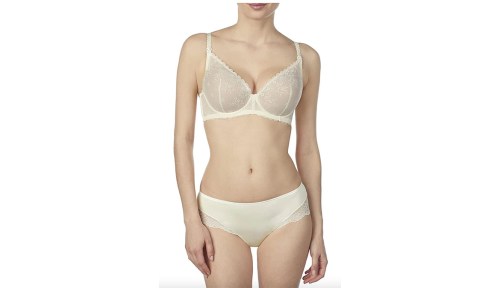
Le Mystere, Women's Sexy Mama Nursing Bra — $54.00
If you’re looking for a beautiful, supportive bra that doesn’t say “nursing,” we found it. Sizes C-G can indulge in this lacey, underwire bra that is thoughtful in design. It has one handed clips, brushed closure and four hooks for a more custom fit. If you are small frame, large bust, this is a hands-down best choice.
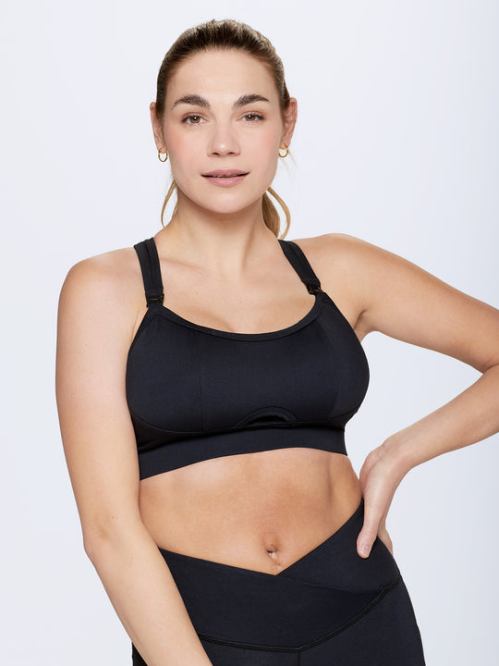
AFTER9, Power Peek-a-Boo Nursing Sports Bra — $125.00
This sports bra is especially designed for nursing mothers, with a foam interior to prevent leakage and a mesh nursing inlet for breathability. “Seriously supportive for all the months, this will get you through late stage pregnancy and far beyond,” says Altman. “When you’ve finished nursing, you can send it in to be ‘converted’ into a regular bra! Ethically made in Canada, this fierce bra will get you throughout workouts— which now include the hardest workout— being a mama.”
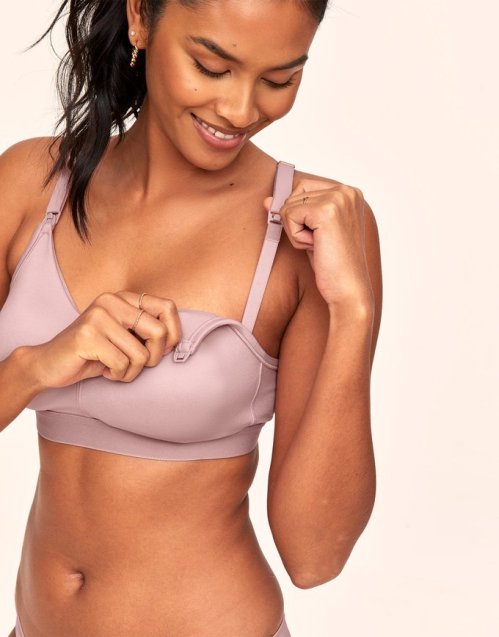
AdoreMe, Leakproof Nursing Bra — $55.00
Leakproof and nursing in the same sentence? Sign us up! Altman says this bra has a stretchy full coverage neckline that provides optimal support and enough compression to firmly hold any wearable pump in place. More (or equally important) it comes with washable and reusable pads made to catch even the heaviest leaks. #momlife
Best nursing bras for sleeping and/or comfort
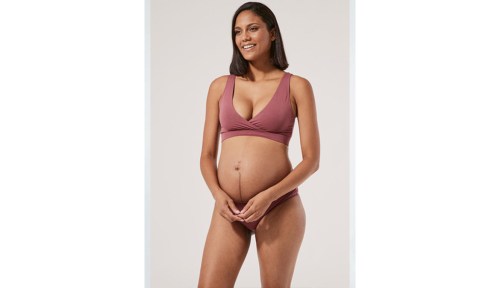
Pact Maternity, Nursing Bralette — $28.00
Hello, simplicity! You’re just what we’ve been looking for! These organic cotton bralettes (made in a fair trade factory) are stretchy and easy to wear before, during and after nursing. Crossover style means you just pull the cup to the side for feeding sessions. They feel good and grow with you throughout the day. Heck, feel free to wear them through the night since there’s no hardware or wire.
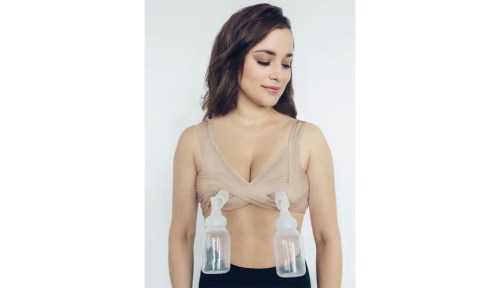
The Larken X Bra — $48.00
We heard this bra had sold out five times, and had to know why. It’s because this super soft pullover bra is more like a tank than a traditional bra. Wear it for nursing or as a hands free pumping bra—the buttery stretch fabric adapts to your changing size without any hardware or fuss. One mom, who refers to nursing bras as her nemesis, said this bra changed her breastfeeding/pumping experience entirely!
Want to be the first to hear about the latest (and greatest) SHOP product drops, custom collections, discounts, and more? Sign up to have the intel delivered straight to your inbox.
Sign up for the Well+Good SHOP Newsletter
Get exclusive deals on wellness, beauty, fitness, and food products that have been hand-picked by our editors.
Got it, you've been added to our email list.

